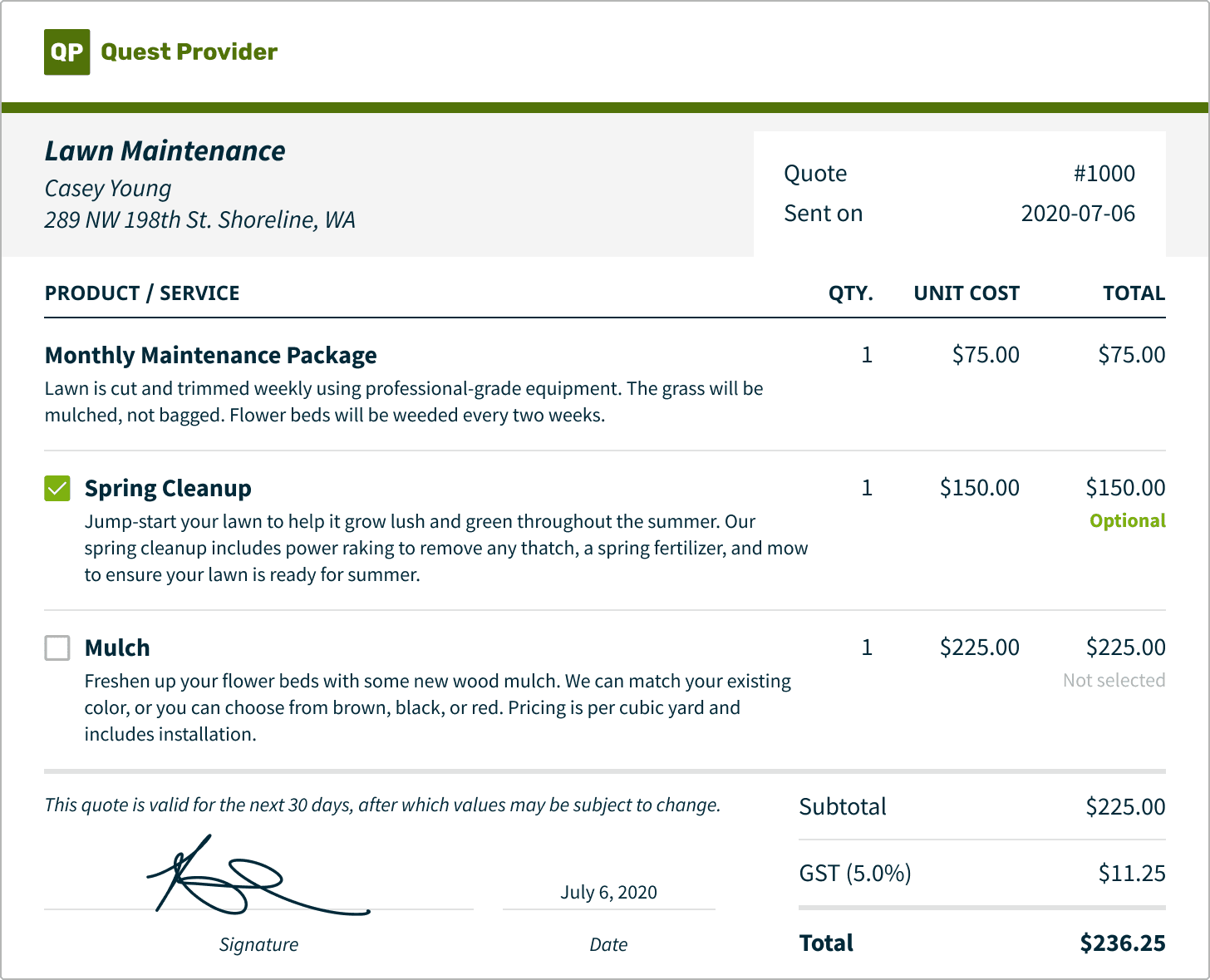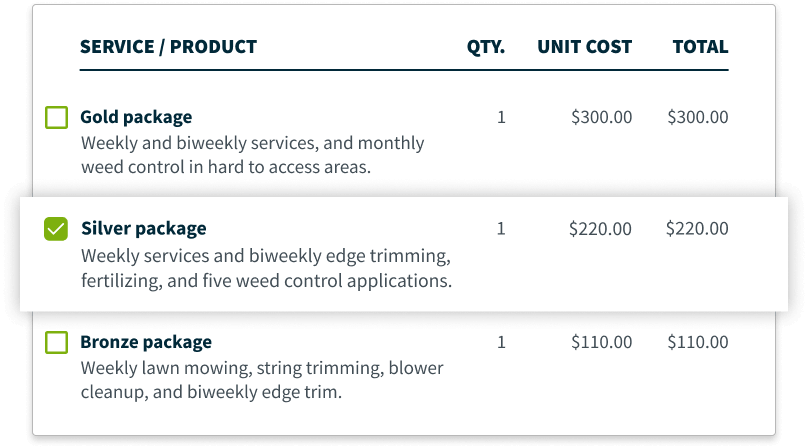4 Ways Itemized Quotes Help You Grow Your Service Business
You’ve put in time and money to attract a potential customer. Now you need to create an accurate, professional-looking quote on a tight schedule—before that prospect takes their business elsewhere.
This is where itemized quotes can help. Using quotes with line items can help you speed up your quoting process, sell more services, communicate better with customers, and save time for your whole team.
What is an itemized quote?
An itemized quote breaks down the costs of a job into line items. Instead of providing a lump sum cost for the job, itemized quotes show pricing for each product or service.
Line items help clarify the quote’s final price and show your prospects what they can expect out of the job. You don’t need to include every single tool and material, but the right details can help your quote stand out from competitor quotes.
Many home service business owners use itemized quotes to upsell, cross-sell, and give their customers more options for the services they need.
Examples of itemized quotes
On the roofing quote below, line items show each part required for the installation, as well as quantities and prices. Descriptions underneath each line item help the client understand why the parts they’re paying for are necessary for the job.

This lawn care quote uses line items to let the customer add optional services to their monthly maintenance package and visualize how these services would enhance their lawn:

Your itemized list might include product options if the customer needs to choose hardware to install in their homes. The plumbing quote below includes images to help the client decide.

Why are itemized estimates and quotes important? How do they help your business?
Itemized quotes can help you add efficiency to your home service business and make the quoting process easier for you, your team, and your customers. Here’s how:
1. Set clear expectations and communicate effectively with customers
You provide value to your customers in lots of different ways. Itemized quotes place that value front and center.
With all the job details laid out in one place, customers know what to expect—and you skip back-and-forth emails and texts for clarification because all the info they need is in the quote.
Line items on your quote help outline your customer’s selections and the services you promised to deliver. So during and after the job, there won’t be any disputes about what work the job included.
You can also avoid price misunderstandings when it’s time to invoice. In Jobber’s quote management software, all the line items on your quote get copied over to the invoice when the job is done.

2. Streamline the quoting process, online and on the app
Once you create a line item for a product or service in Jobber, it stays in the system so you can use it in future quotes.
This saves you from going back into previous quotes to see how you described each item before—and it keeps your messaging consistent.
When you’re meeting the customer to discuss the job, you can make a quote on the spot (right on your phone or tablet) by adding those services and products as line items.

3. Let team members help with the quoting process
Itemized quotes allow your whole team to put the same amount of detail into quotes as you and your senior team members.
Once you set prices and descriptions for each product and service, all that information will appear when your team members plug in line items onto the quote.
When you can’t be there with a client, you can trust your employees to easily create a quote on their smartphones or tablets with the pre-existing line items you’ve added to Jobber.
They’ll be able to sell and estimate just as effectively as you or your sales team while avoiding guesswork that could cost you the job.
READ MORE: Price quotes: A short and easy explainer for business owners
4. Efficiently communicate job details and instructions
Itemized quotes put everything on the table, making it clear what value you’ll deliver to the client. Line item descriptions allow you to explain why you’re including a certain product or service—whether it’ll enhance the quality of the job or make your work more efficient.
A detailed line item description, like the one below, makes it clear why you’ve chosen that product for the job.

They also let you offer basic instructions to the team member you assign to the job:

READ MORE: Should you charge for your estimates?
What should contractors include on an itemized quote?
Depending on the type of work you do, you might include line items for:
- Installation costs
- Product options
- Phases of the job
- Services that involve more labor than expected
- Major parts or materials you need to purchase for the job
- Recommended add-ons
- Tiered packages with different pricing
- Product warranties
- Special requests from the client
Some costs are impossible to estimate before the job starts. Look into your job history to decide what prices are predictable enough to include on the quote, and which aren’t.
If jobsite conditions or square footage are likely to affect your job costs, put together an estimate before you create the final quote. Be sure to build your profit margins into those costs—but don’t include them on the quote.
It could take some trial and error to figure out what’s best to include your itemized estimates. Once you find what works, repeat the process and pay attention to what line items your clients are choosing the most.
READ MORE: Cost estimates vs budgets: how they affect your pricing
How do you create your own itemized quotes?
Creating an itemized quote using quoting software like Jobber is a simple process.
You can create a service or product with a name, description, and price directly from the quote builder, and that turns into a line item on your quote.
Here’s what that looks like:
Consider using these three elements to help you build effective quotes:
1. Line item images
In Jobber, line item images in quotes show up right beside the line item, along with the item description, quantity, and cost. These are especially useful when you’re offering your customer different product or material options.
You could even include a photo of your customer’s property, with notes or drawings to show the changes you plan to make.
The itemized quote example below includes an image of the client’s property. It keeps a record of the trees the arborist needs to remove, protecting them from a costly mistake.


2. Optional line items
Add optional line items to your itemized quote to offer customers add-ons that could enhance the job. On average, this upselling technique can increase quote totals by 35%.

You can also use optional line items to create good, better, best pricing packages. This lets customers choose the level of service they want, while helping you close higher-priced jobs.
Text descriptions underneath these line items tell customers what comes with each tier of service. Here’s an example of a lawn care quote with different service tiers:

3. Line item discounts
You might have offered 25% off one of your services to all new customers, or added an additional service for someone at a special rate.
Build those into your quote easily by adding discount line items. These act just like regular line items in Jobber, but with a negative unit price.
Instead of waiting to add discounts on the invoice, you can get a few steps ahead by factoring in those discounts at the quoting stage.
Best practices for itemized quotes
To make a winning itemized quote for every job, make sure you:
- Add detail. Include everything your customer should know about your products or services. That could look like specifications for each product option (e.g., dimensions, material composition) or all the work included in your tiered packages.
- Be concise. As important as detail is, try to keep things as short and easy to read as possible. Your customers may be eager to get the work done, but they also want the process to be simple and painless.
- Write with your customer in mind. Try to avoid terms from your industry that customers wouldn’t understand after a quick Google search (like “charging a system” in HVAC or “EHV” instead of “extra-high voltage”). Remember, this could be your customer’s first time paying for this kind of service.
- Check for typos.This isn’t the most urgent part of the process, but keeping your estimates error-free keeps you looking professional. Proofread every line item to look out for mistakes that could confuse your customer.
- Follow up on your quote. Once you send the quote, don’t let it slip through the cracks. Your customers have flooded inboxes, so it’s easy to miss things by mistake. The best way to keep sending reminders is to automate your quote follow-up process
Use itemized quotes to win jobs and streamline your workflow
For Halli Sanchez from Blutex Pools, it takes more than price to stand out against competitors. “We’re finding that customers aren’t just going with the cheapest quote in their inbox,” Halli says.
She noticed a difference when her small business started sending itemized quotes.
“Customers can see the breakdown and value of the cost differences between options we’ve given them, and we’ve seen a good return on customers going with the higher-priced options because of that breakdown and transparency.”
Adjusting your quoting strategy could translate to more sales and faster growth. And when you make your quoting process more efficient and get your team more involved in selling, that growth can only multiply.